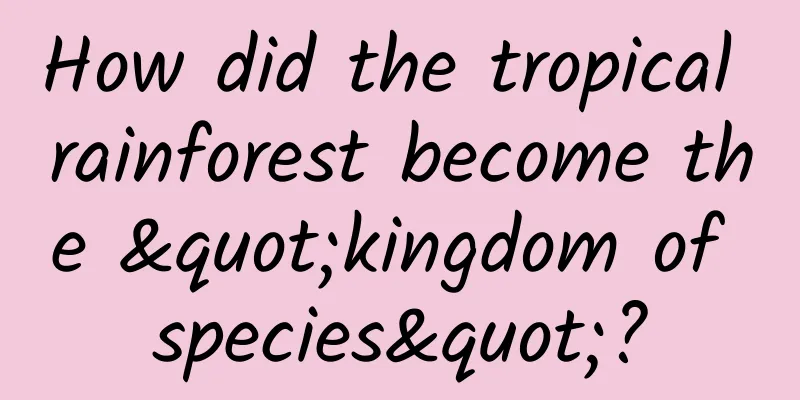How did the tropical rainforest become the "kingdom of species"?

|
Produced by: Science Popularization China Author: Supercontinent Team Producer: China Science Expo The tropical rainforest is the most luxuriant forest vegetation on our planet, with the richest species composition, the most complex hierarchical structure, the most diverse community appearance, and the most peculiar life phenomena, making it the most precious ecosystem on our planet. (Photo source: Veer Gallery) What is a "tropical rainforest"? Tropical rain forests have unique appearance and structural characteristics, which are clearly different from other forest types in the world. Tropical rain forests mainly grow in tropical humid lowlands with an average annual temperature above 24°C or an average temperature of the coldest month above 18°C. It is distributed in the three major tropical regions of the world: the Indian Malay rainforest, the African rainforest, and the American rainforest. (Photo source: Veer Gallery) Although the rain forests in tropical America, tropical Asia and Africa are divided into three major areas, they all have very similar appearances and structural characteristics. Due to the hot and humid environment all year round, tropical rain forests grow tall and dense, generally more than 30 meters in height, and the tallest trees can grow to more than 80 meters in height. Layers of family When you step into the tropical rain forest, the dim light and the sky blocking out the sun make you feel as if you have entered the chaotic ancient times, and a feeling of fear arises spontaneously. This is what the explorers have recorded. Tropical rainforests are a primitive type of vegetation that has not been affected by glaciers in geological history. The long-term stability of the climate and environment in tropical regions, coupled with the favorable conditions of high temperature and high humidity all year round, allow the forests to grow very lushly, forming a tall and multi-layered structure. (Photo source: Veer Gallery) The trees are of different sizes and heights, forming three to four tree layers. The first tree layer is usually over 30m high, with their crowns sticking out like giant trees towering above the forest canopy below; the second tree layer is made up of large trees 20-30m high, with dense crowns, forming the main layer of the forest canopy; the third tree layer is 10-20m high, made up of medium and small trees, with a high tree density; there is usually a small tree layer at a height of 5-10m. Below the tree layer is a 1-5m high sapling shrub layer. The shrubs in the tropical rain forest are almost indistinguishable from the small trees in appearance, no wonder some people call them "Zhuru trees". Below the sapling shrub layer is a herbaceous layer with varying densities. As the forest has multiple layers, almost no direct light can reach the ground, so it is very dark and gloomy under the forest, and it is difficult to tell the time. Looking at the tropical rainforest from a distance, you can see huge trees with light-colored trunks rising above the green canopy, like a forest within a forest. (Photo source: Veer Gallery) The trees in tropical rain forests are very unique in shape. They grow tall and thin, with light-colored, thin and smooth bark. They only branch near the top of the tree to form a hemispherical or rectangular crown. In many cases, their light-colored bark is due to a layer of algae or ground-dependent plants growing on it; the thin and smooth bark is not necessary to resist low temperatures and drought, and it is difficult for epiphytes to grow on it; and the thin stature and tall crown branches are an adaptation to the high density of tropical rain forest trees and competition for light. Rich "species kingdom" Although tropical rain forests only account for 7% of the world's land area, they contain half of the world's total number of plants. As Wallace wrote in his diary, it is a futile effort for a traveler to find two trees of the same species in a tropical rain forest. (Photo source: Veer Gallery) Conclusion As scientists explore and study tropical rainforests, more and more ecological phenomena are being discovered and explained. However, more and more discoveries also reveal that tropical rainforests contain a large amount of biological knowledge and natural laws that have not yet been fully understood. In particular, the extreme richness of tropical rainforest species and the diversity of plant life types are difficult to explain with Darwinian natural selection and remain a mystery. Editor: Sun Chenyu |
<<: If you don’t want the pressure cooker to explode, you must do this step right! !
Recommend
How much does it cost to make a beauty mini program in Xing'an League? What is the quote for making a beauty mini program in Xing'an League?
The mini program provides convenience for publici...
Don’t waste your money, here are some tips on placing Douyin DOU+ ads!
This is a purely practical article about DOU+ del...
How much do you know about the information flow advertising routines of highly profitable products?
After reading this article, I hope you can improv...
Why are all the ads I see on TikTok games?
Capture SSS-level Lingkun at the beginning, 5th t...
Practical experience | Talk about the two doors of offline event promotion
Today we are discussing the data problems encount...
The most popular marketing copywriting skills in 2020!
If you want to write a popular marketing promotio...
Xing Ming, President of Tianya Community: I accidentally entered IT industry. Five reflections I have made over the past 17 years
What I wanted most was to be a journalist, but so...
A complete guide to operating work and improving operating skills
I have been engaged in Internet operations for on...
Year-end review: Top 10 most popular marketing cases in 2018
It’s the end of the year again, and it’s time for...
Review of marketing cases in Q1 2022!
In a blink of an eye, three months have passed in...
iPhone 6 is not new to Chinese users
Several people familiar with the Chinese mobile d...
Huyong.com SEO: SEO optimization practical training video tutorial
Hu Yong’s personal profile: He started studying S...
Complete information flow promotion plan for 5 major industries! Take it for reference~~
Nowadays, mobile advertising is experiencing expl...
You think the sea is blue? Actually, your eyes deceive you.
Is the ocean really blue? In a study published in...
The ten major functions and effects of liquor. What are the functions and effects of liquor?
Chinese culture has a long history. The wine cult...









